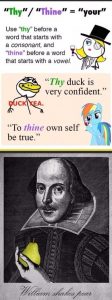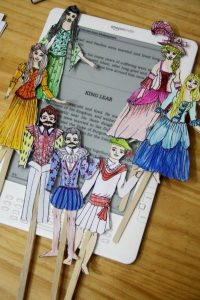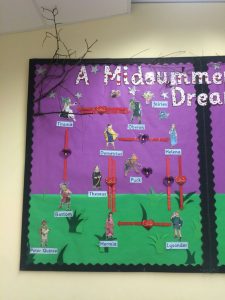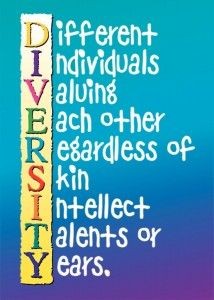Classroom Drama
September 23rd, 2016
Including Shakespeare in the classroom is essential. Shakespeare, and drama itself, can be used to teach many aspects of English. Shakespeare and drama can be used to teach diversity, language varieties, writing styles, reading, oral abilities, and much more. It can even be used to teach confidence in the classroom by getting students reading and acting in front of each other. 

The ASC’s production of Romeo and Juliet at Longwood University this past week was phenomenal. The performers truly commanded the stage and captured the audience in a way I have never experienced before. The performers were able to make the audience feel as though they were part of the story. Their use of emotions to deliver the lines made the play much more understandable. There were many middle school students at the production, and watching them you could see how well they were able to grasp what was being said, and what was portrayed on the stage.
There are many interesting ways to teach drama. A few examples include:
- acting plays out
- group read aloud where students wear or hold a prop to indicate which character they are reading
- read aloud using stick puppets(pictures of characters on sticks)

- group students together and allow them to create their own take on the play and each group act it our for the class
- take lines from Shakespeare and have students translate the lines in modern English, a rap, or a text message
Taking a difficult play and breaking it down is a great way to help students understand it more. Teachers can break students into groups, and have each group create a character “family tree” so they can see who each character is and who they are related to. Students can even include who the character’s friends are in the tree. This activity is called “Character Connections” in the American Shakespeare Center’s study guide (Morris, 2012).
 With Shakespeare, teachers can also teach iambic pentameter by lining students up in chairs and standing to show the stressed and unstressed parts.This activity is described in the American Shakespeare Center’s Study Guide as well.
With Shakespeare, teachers can also teach iambic pentameter by lining students up in chairs and standing to show the stressed and unstressed parts.This activity is described in the American Shakespeare Center’s Study Guide as well.
Shakespeare can also be used to show the origin of many of the words we still use today. 
The American Shakespeare Center’s study guide gives an abundance of activities teachers can use to teach Shakespeare in the classroom. This guide is extremely helpful in giving ideas that can even be adapted to teach other plays as well as Shakespeare’s plays.
Drama is such versatile teaching tool, and can be used in many ways in the classroom to teach a plethora of things. It is also a wonderful tool, because students enjoy it. Drama is a fun way to get students involved in their learning, and help them solidify it in their minds so they can remember what they’re learning much better.
All visuals from Pinterest.com
Morris, C. 2012. American Shakespeare Center Study Guide Romeo and Juliet.
Same Ol’e, Same Ol’e
September 14th, 2016
First, I think it is important we are on the same page as to what “diverse” and “social justice” mean, and what “diverse learners” are. “Diverse” means to be different from each other. “Diverse learners” are students who are different in some way, such as, ethnically, racially, linguistically, or culturally. “Social justice” is the belief in human equality and fairness.
 To me, a teacher who is effectively supporting diversity and social justice in the classroom is someone who is fully aware of the diverse learners she or he is educating. This teacher is also able to address the topic of diversity amongst the students in her or his classroom appropriately. Doing this would include the teacher being able to provide readings that promote diversity in her classroom in order to show that diversity is important in having a great learning experience. As a teacher, I would do this by using other examples such as having diverse meals. I would ask the students if they would want to eat the exact same meal every single day for the rest of their lives. Their answer being no, I would then ask them to make a list of the foods they love to eat. I would already have a list of foods of my own that I could describe where they came from. This list could be American foods that originated in other countries or cultures (pizza and spaghetti are Italian), or it could be different ethnic foods (Mexican and Chinese). With this introduction, I could then explain to students that spending time with people of different races, ethnicities, religions, cultures, etc. is just as important as having diverse meals.
To me, a teacher who is effectively supporting diversity and social justice in the classroom is someone who is fully aware of the diverse learners she or he is educating. This teacher is also able to address the topic of diversity amongst the students in her or his classroom appropriately. Doing this would include the teacher being able to provide readings that promote diversity in her classroom in order to show that diversity is important in having a great learning experience. As a teacher, I would do this by using other examples such as having diverse meals. I would ask the students if they would want to eat the exact same meal every single day for the rest of their lives. Their answer being no, I would then ask them to make a list of the foods they love to eat. I would already have a list of foods of my own that I could describe where they came from. This list could be American foods that originated in other countries or cultures (pizza and spaghetti are Italian), or it could be different ethnic foods (Mexican and Chinese). With this introduction, I could then explain to students that spending time with people of different races, ethnicities, religions, cultures, etc. is just as important as having diverse meals.  I would also talk about how these very different types of people will all have such different experiences and bring extremely interesting things to writing. I would go back to showing poems and excerpts and even songs written by diverse people and point out and discuss how different their lives could be from theirs and how it is incorporated into their writing. I would then have each student write a short piece about a life experience they have and pair up with someone to see how their lives differ or are the same. I could even show the movie Zootopia or just clips from it to show diversity issues. To bring out social justice, I would bring in news articles on what is going on in todays society with issues such as Black Lives Matter and whether or not to let refugees into the U.S. I would use topics that are extremely controversial and get students to speak up about what they think is fair and unfair. I would also use stories about Rosa Parks, Martin Luther King Jr., Hispanics in California, and any others I can find. Class discussions on this topic would be easy to start and guide down the road of everyone being kind to one another and treating each other fairly in attempt to avoid issues of social justice in their lives. I would show student’s that they have a responsibility to do everything they can to promote equality and fairness for everyone, and they can start in the classroom.
I would also talk about how these very different types of people will all have such different experiences and bring extremely interesting things to writing. I would go back to showing poems and excerpts and even songs written by diverse people and point out and discuss how different their lives could be from theirs and how it is incorporated into their writing. I would then have each student write a short piece about a life experience they have and pair up with someone to see how their lives differ or are the same. I could even show the movie Zootopia or just clips from it to show diversity issues. To bring out social justice, I would bring in news articles on what is going on in todays society with issues such as Black Lives Matter and whether or not to let refugees into the U.S. I would use topics that are extremely controversial and get students to speak up about what they think is fair and unfair. I would also use stories about Rosa Parks, Martin Luther King Jr., Hispanics in California, and any others I can find. Class discussions on this topic would be easy to start and guide down the road of everyone being kind to one another and treating each other fairly in attempt to avoid issues of social justice in their lives. I would show student’s that they have a responsibility to do everything they can to promote equality and fairness for everyone, and they can start in the classroom.
[youtube]https://youtu.be/l-gQLqv9f4o[/youtube]
A teacher can have a massive impact on students and how they view diversity and social justice, amongst many other important topics. It is a teacher’s responsibility to show students the need for diversity and how social justice makes it possible to have differences. I want to teach my students about the important of having differences and how they make us grow and give us perspective. Without differences, life would be boring. I also want to teach my students how social justice is what makes diversity possible. Making a stand to promote social justice in their lives is important for them to do now, so that they can do it as adults.
A teacher should also focus on diverse learners. Not only does their race, religion, culture, ethnicity affect how they learn, but can also be different linguistically. Everyone has a different dialect and we as teachers must be aware of this and show students that their dialect is right, but not always appropriate to use. We also often have students who speak entirely different languages and have to figure out how to adapt our lessons to accommodate their linguistic needs. This can be especially difficult, but teachers must be willing to enlist the help of others.”We need a range of strategies to cope with the different students and their challenges. We also need to remember that their challenges are more complicated than just the acquisition of a language” (Burke, 2012, p. 380). If I am ever in the situation to teach a student who speaks another language, I plan to implement practices such as speaking slowly, using gestures, giving directions with illustrations, giving them a partner that can show them what to do, and talking with ELL teachers for help (Burke, 2012, p. 380).
I want my classroom to be an extremely welcoming environment where students feel they can talk to me about anything and feel heard and important. I want students to all feel like they are equal in my classroom, no matter their class, race, culture, etc. All students deserve the opportunity to be heard and learn everything they can.
[youtube]https://youtu.be/RwlhUcSGqgs[/youtube]
All pictures are from: https://www.pinterest.com/search/pins/?q=diversity%20humor%20kids&rs=typed&term_meta[]=diversity%7Ctyped&term_meta[]=humor%7Ctyped&term_meta[]=kids%7Ctyped
Burke, J. (2008). The English Teacher’s Companion: A Complete Guide to Classroom, Curriculum, and the Profession, 3rd ed. Portsmouth, NH: Heinemann.
Rags to Riches
September 2nd, 2016
Commented on: Haley & Taylor’s blogs
I was lucky enough to grow up with a father who was willing to be the sole provider for my family, and a mother who was willing to stay home to spend her days teaching me, instead of going to work and building her own life outside of my family. This enabled me explore many topics as in depth as I desired. Growing up homeschooled has its many advantages. Some of which include, sleeping until 9:30, doing schoolwork in PJs, and having family vacations built around history lessons. There are also a few disadvantages to being homeschooled. One major disadvantage for me was not being given a strong foundation in English and Grammar. My education is well rounded in all other subjects and areas. My knowledge and love of English came from my independent studies. The only way my mother could teach English was straight from the textbook and provided worksheets. This facilitated a hatred of grammar. It wasn’t until I reached high school that I began seeing the patterns in sentences that I needed to follow in order to write. I never truly learned the grammar rules or even understood them. I, instead, learned by following the example I found in the books I read in my literature classes. My experience with English was limited, but I still had the freedom and time to do my independent studies to learn all that I could.
I want to teach in a way that I can give my students a similar education as the one I had. One filled with endless opportunities to explore and discover of my own with my mother/teacher there to facilitate and occasionally guide my learning. I want to teach in a way that encourages students to explore what interests them, while also learning all that they will need to succeed in the world and their futures. I hope to instill in my students the same thirst for knowledge that my parents instilled in me. The opportunities that my parents were able to give me through homeschooling is what gave me the desire to learn and to teach.
I am currently learning about assessments and what types of assessments will be most helpful to me and my students. “Authentic assessments of reading employ tasks that reflect real-world reading practices and challenges”(Read Write think). This is mildly overwhelming for me, because I didn’t have assessments in my education. I was so intensely excited about what I was learning that I wanted to talk about all of it with anyone who would listen, which usually was my mother and father. This gave my mother a clear understanding of what I was excelling or struggling with. This, I feel, puts me at somewhat of a disadvantage with my peers in class. To me, this only means I will work harder to understand, so that I may be a better teacher with each new thing I learn.
Having zero experiences in a classroom makes it somewhat difficult for me as I learn how to be a teacher, but I am determined to make it an advantage. I hope that my lacking knowledge of a typical classroom will give me room to create a classroom environment that is better equipped to use what I am learning now, instead of falling into patterns that other teachers tend to fall into. In a class discussion recently, we talked about how teachers can get lazy and lean on the typical lecture style of teaching, instead of continuing to make lessons more individualized to better student education. Because I have never been a part of this teaching style, I hope that I will be at an advantage to stay away from that pitfall.
Making the reading process visible through performance assessment. (2016). ReadWriteThink.